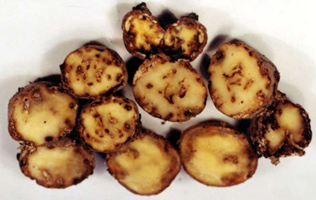Tuber Worm
Tuber Worm name for the larva of a small moth Phthorimaea operculella of the family Gelechiidae, order Lepidoptera infesting potato both under field and storage conditions. The adult moth has body length ranging from 6 to 8.5 mm. The forewings are grey, mottled with black and dark brown spots, with short fringe of hairs on the apical margin. Hindwings are light grey, shorter and narrower than forewings, bordered with a fringe of long buff hairs extending from apex around the apical and anal margins. Adult female may lay up to 100 eggs attached to the host plant or tubers or any substratum nearby.
After hatching the tiny larva measuring about 1.25 mm in length mines into the tuber. It makes characteristic tunnels within the tuber. Pupation occurs outside the tuber on epidermis in a silken cocoon. Life cycle occupies 18-25 days depending on the prevailing temperature.

Presumably the potato tuber moth (PTM) was introduced to British India at the end of the 19th century through seed potato tubers imported from Italy. It gained entrance to this part (now Bangladesh) in between 1902 and 1907 initially to potato growing areas of Rangpur, Bogra, Rajshahi and Mymensingh districts. At that time seed potato tuber used to be imported from Uttar Pradesh and Bihar of India. Fortunately, in Bangladesh PTM is not a problem under field conditions. The pest causes a serious damage to the farmer’s homestored (non-refrigerated) potatoes in this country. Most economic damage by the PTM occurs when the larva infests the tubers both in the field and in the stores, rendering them unfit for human consumption. Foliar infestations may also cause yield losses specially when the larva mines the stem and kills plant tissue.
In Bangladesh the extent of damage by the tuber worm varies depending upon the storing methods and environmental conditions. There are instances of 100% damage in the farmer's homestored potatoes in some locations. The indigenous varieties, particularly the Lal-Pakhari or Bogra variety is more susceptible to worm attack and wide-spread damage is incurred in Pabna, Bogra, Rangpur, Dinajpur, Joypurhat and Sirajganj districts. The initial infestation of the tubers by the worm and the subsequent infection by the microorganisms often may cause complete damage of the homestored tubers.
The insect does not show hibernation period and may pass through as many as 18 overlapping generations a year. Potato tuber moth is an oligophagous insect feeding on host plants limited to a few genera of the family Solanaceae. Besides potato, it infests tobacco, Nicotiana tabacum, tomato, Lycopersicom esculentum, and brinjal, Solanum melongena. [Anwara Kabir]
See also potato.
